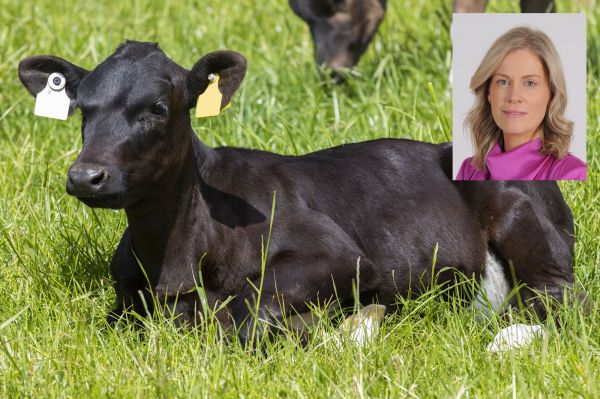Reducing the risk of pneumonia in calves at turnout

Respiratory disease is commonly seen in both dairy and suckler calves. It is the most significant cause of death in cattle greater than one month of age in Ireland. There are substantial long-term implications of respiratory disease on productivity for both dairy heifer and beef calves, with reduced milk yield and reduced average daily gain respectively. Therefore, it is imperative that farmers implement a strategic plan pre-turnout to maximise calves’ immunity in conjunction with minimising infectious pressure.
What causes pneumonia in calves?
It’s a complex interaction between the animal, pathogens (bacteria, viruses and lungworm) and the environment. A primary viral infection can compromise lung defence mechanism. Subsequently, calves are predisposed to bacterial infection of the lower respiratory tract. It is therefore fundamental to monitor calves frequently post-turnout to observe for clinical signs of disease. Clinical cases of pneumonia may present with all or some of the following signs: nasal or ocular discharge, increased rate and effort of respiration (pant), fever (greater than 39.5oC), off-form, poor appetite and coughing. Contact your veterinary practitioner to promptly diagnose and treat cases accordingly when these clinical signs are observed. There is a seasonal peak in cases of pneumonia from September to October. However, it is worth noting that the threat of pneumonia is omnipresent. Pneumonia can occur at any stage of the year whether calves are indoors or outdoors.
Why does turnout present a risk?
There are multiple stressors associated with turnout which include change of diet, change of environment, unfavourable weather conditions and commingling. These stressors negatively impact the calves’ immune system resulting in increased susceptibility to developing disease, notably bovine respiratory disease, of which pneumonia is the main syndrome. Turn out healthy calves only, if possible, on a mild day and maintain concentrate feeding for at least one month, typically 1kg per animal per day, to mitigate stress.
Weather conditions in April and May can be unpredictable and unfavourable. The changeable nature of the weather is a major predisposing factor for calves to present with pneumonia, in particular pneumonic pasteurellosis, which can be caused by a bacterium, Mannheimia haemolytica. A well-sheltered paddock is recommended for youngstock at turnout in tandem with a vaccination programme, preferably incorporating cover against M. haemolytica.
Vaccination is a vital component of the control measures to reduce the risk of pneumonia, as it enhances immunity by stimulating production of antibodies. Vaccination will reduce infection and clinical signs of pneumonia. Bovilis Bovipast RSP protects against both viral and bacterial agents namely PI3, RSV and provides the broadest protection against M. haemolytica, which is frequently the principal bacterial agent implicated in pneumonia. The use of IRP technology enables cross protection against two serotypes of M. haemolytica, A1 and A6, ensuring the broadest protection available against M. haemolytica. Recently, many farmers vaccinate new-born calves to provide protection against two viruses, RSV and PI3. For example, Bovilis INtranasal RSP is licensed for administration from the day of birth.
Further vaccination?
Do these new-born calves vaccinated against RSV and PI3 require further vaccination against pneumonia? Bovilis INtranasal RSP has a duration of immunity of 12 weeks, thereby providing protection in the early critical high risk first few months of life. However, prior to, or at, turnout this protection may have lapsed. To provide protection against RSV, PI3 and M. haemolytica, Bovilis Bovipast RSP can be administered. A primary course comprises of two subcutaneous (under the skin) doses four weeks apart, with an onset of immunity of two weeks. Ideally, calves should receive the second dose two weeks pre-turnout as the second dose results in an increased antibody titre and thus improved protection. Nevertheless, due to potential time constraints and the timing of turnout, the second dose can be administered post-turnout. Ensure to use sterile clean needles and syringe for administration. It is also vital that vaccines are stored correctly. For instance, for Bovilis Bovipast RSP, it must be stored at 2-8oC and used within 10 hours of first opening.
Clostridial diseases
Also, it is worth noting the importance of providing protection against clostridial diseases pre-turnout. There are many syndromes associated with clostridial disease in calves. Blackleg is the most commonly known syndrome. Clostridial diseases are not contagious. However, they are highly infectious and ubiquitous. The clinical presentation of the disease will be dependent on the causal bacteria involved, but they are often associated with acute/sudden deaths. When vaccinating against clostridial diseases it is important to follow the treatment protocol, typically involving two doses, four to six weeks apart. It is also important to ensure there is a strategic worming protocol implemented to reduce parasitic respiratory disease as first season grazers have no acquired immunity to lungworm, unless they are vaccinated in advance of turnout.
Implementing the recommendations outlined above will aid in reducing the risk of pneumonia and ultimately positively impact health and welfare of the calves at turnout. Act now to reduce potential losses and contact your veterinary practitioner for further information and to discuss vaccination programmes suitable to your herd.





